EHS MINI HOLIDAY - SUMMER 2014
GARDENS OF FIFE & ANGUS
See also the
picture gallery
Saturday 19th July 2014
51 of us set off in pouring rain early with our first stop at Tebay Services for 15 minutes and then on to Abingdon Services for a lunch break. Our first visit was to the Royal Botanic Garden in Edinburgh where we also met our tour guide Julia Corden, a head gardener who trained first at RHS Wisley and then at the Botanic Garden in Edinburgh. We were introduced to the new tufa rock wall with its unique watering system from behind and its canopied glass roof. Commissioned a year ago, its tiny alpines have already doubled in size and it is hoped that the entire rock face will be completely covered within five years. Then on to the famous alpine Rock Garden and into the wonderful pre-Victorian elegant Glasshouses, housing the temperate Palm House, the Orchid and Cycad House with orchids, water lilies with huge lily pads and the beautiful, delicate pale pink lotus flower and the Fern and Rainforest Houses. What an experience and a taster for a return visit – then off to our base, the Park Hotel in Montrose, via Dundee for dinner. | 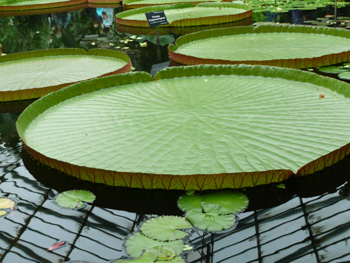 |
Sunday 20th July
With much improved weather, our first visit was to Terrill Dobson’s Herbalist Garden set in the walled garden with a Victorian greenhouse at Logie House. The herbs are grown in eight individual box hedge areas, each designated to a particular body system with a description of each herb and its uses. Terrill teaches the ancient art of the herbalist and produces teas and tinctures in the clinic, with most of us sampling her Happy Tea! The garden also included an herbaceous border and very productive fruit and vegetable garden with apple and plum trees lining the sheltered south-facing wall. Fruit trees in a glass house along the same wall contained figs and ripe peaches. |
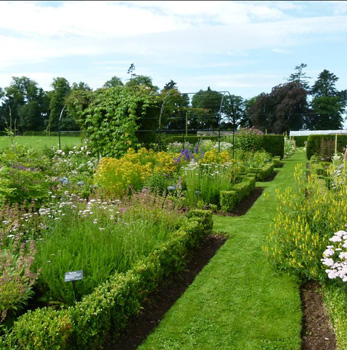 |
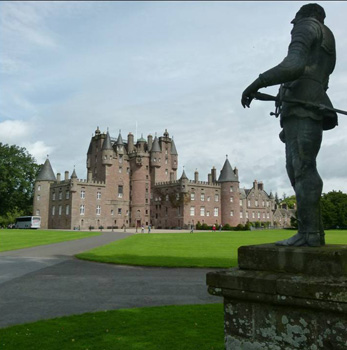 |
We went on to Glamis Castle, the childhood home of the late Queen Elizabeth, the Queen Mother. The Italian Garden featured fan-shaped parterres of formal beds, with lavish plantings, alleys of beech and bounded by yew hedging. After years of decline, the Walled Garden, which used to produce food for the castle, is now being renovated by the present Earl and Countess. Quite a few of us also took the very interesting guided tour of the castle – a very homely, lived-in residence. Our final visit for the day took us to Pitmuies Gardens, between Arbroath and Forfar – an amazing garden which until early this year was tended by Margaret Ogilvie, and described by her daughter-in-law as a “garden within a garden, within a garden”. Huge herbaceaous borders, one of which contains plantings in colours to tone with one of the rooms in the house are separated by lawned walkways to terraced rose gardens and continue down the garden to a riverside walk where a grand dovecote can be found. With a kitchen garden, woodland walks, and an alpine & wildflower meadow in summer, this is a lovely tranquil garden which we saw on a beautifully sunny day. Margaret Ogilvie sadly died in May 2014 but her garden continues to be well-cared for by her son and daughter-in-law who moved into the house in 2013. |
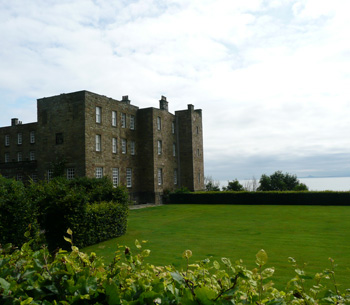
| Monday 21st July
Another hot, sunny day we made an early start for the first of four gardens to: Wemyss Castle, a large privately owned residence built on the cliffs overlooking the Forth estuary which has been owned by the Wemyss family since the 13th century. We had access to the large formal gardens, which have been extensively redesigned by Charlotte Wemyss and her husband. The higher garden with its shrubs, trees and gravel walkways, contrasts with the lower garden planted with roses, ornamental trees and a large collection of clematis, with complimenting colours being planted together in containers. North Berwick and the Bass Rock – home to the world’s largest island gannet colony – could be seen across the estuary from the castle wall. |
|
We continued to Kellie Castle, the home of the Earls of Kellie at Pittenweem in Fife, a National Trust property and restored by the Lorimer family from the late 1800’s. A large garden, laid out with vegetables and fruits around the outer walls with flowers in the middle section, and a large sundial forming a centerpiece. There are 75 types of apple trees, many of which are older Scottish varieties, gooseberries growing on cordens allowing a lot of plants to fit into a small area and 30 varieties of rhubarb. Opposite the rhubarb, and lining a gravel walkway was a stunning border of Bergamot, which had achieved substantial growth in only its second season. This garden continues to be restored in the style the Lorimers created. |
|
After lunch at Kellie Castle, we journeyed on to Wormiston House, a privately owned old manor house and estate at Crail, built around 1180. The house is undergoing extensive remodeling but we were able to see the beautiful walled garden. We entered through the smaller side entrance with its moon gate and formal ponds and rill on either side and two pavilions in the corners. Looking towards the house, the garden is divided into “rooms” including: a kitchen garden with soft fruit (some of us were lucky enough to sample the strawberries!) and vegetables for house use; a meadow and orchard; a shade garden; a formal garden with a circular lawn, grasses, clematis and many robust perennials; a lovely colourful herbaceous border containing tall delphiniums, astrantia, wild orchids and many other repeating plants. The final “room” – a thistle parterre – low box forming the shape of two entwined thistles was interesting in that the floor was covered in crushed shells which also were in other parts of the garden to give a bright appearance and keep down slugs and snails. |
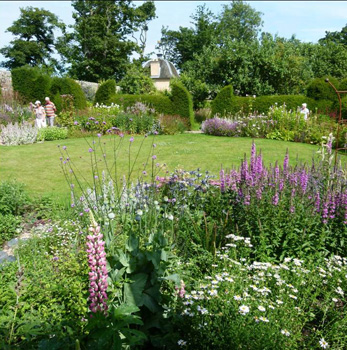 |
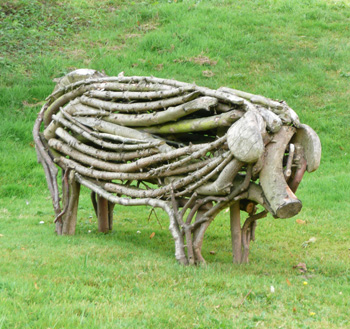 |
Our final visit of the day was a quick visit to Cambo a 30 acre estate north-east of Fife and the home of Sir Peter and Lady Catherine Erskine. The estate is famous for its snowdrops and snowdrop festival in March, having the national collection of over 350 varieties. We toured the “hilly” walled garden with its Victorian greenhouse and two annual wild flower gardens. Other features included a river running through this traditional garden with its little bridges and ever evolving herbaceous displays. Intriguing acrobatic statues appeared to watch over us from the top of the outer wall. After a visit to the little gift shop in which hung a beautiful patchwork quilt of snowdrop patterns, we set off on our way back to Montrose at the end of a very busy day. We reached the Hotel a little late for dinner having had our journey back Fife extended to avoid the scene of a serious road accident. We were pleased to meet and be joined for dinner by Brightwater’s MD Graeme Mitchell. Graeme gave and interesting talk about Brightwater - there were many positive comments despite the long day which had preceded it. |
|
|
|
Tuesday, 22 July
On our final day – yet another hot one – we left our hotel for home via a stop at the New Lanark World Heritage Site, situated on the banks of the river Clyde. Robert Owen managed the mill in the early 1800’s and provided his workforce with decent homes, shops, healthcare and education for the children. We were given an innovative tour of the history of New Lanark, through the experiences of one of the children who lived and worked there which was then followed by a visit to Scotland’s largest roof garden with a raised viewing level and planted with shrubs. Our final stop before heading for home was Carmichael Mill in Lanarkshire. The mill was “rescued” by its present owners who, over 24 years have created the entire garden. A quiet, peaceful, “homely” garden displaying a huge range of trees, shrubs, vegetable garden, herbaceous perennials, annuals and biennials which surround the only remaining workable grain mill in Clydesdale. The garden runs alongside the river and the remains of a medieval grain mill, foundry and lint mill have been found within its grounds. |
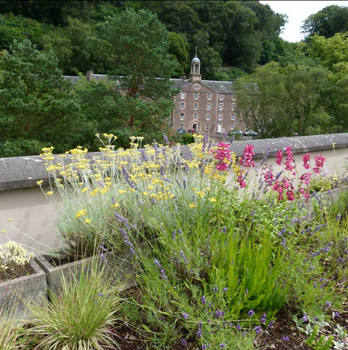 |
|
We all felt very lucky to have had such beautiful weather for our holiday, after the initial rain on the first day. We had a super start with a visit to the Royal Botanic Garden in Edinburgh and during the course of the four days, saw some lovely gardens, some public and some private – all very individual. All in all, a very enjoyable holiday! Pat Whalley |
